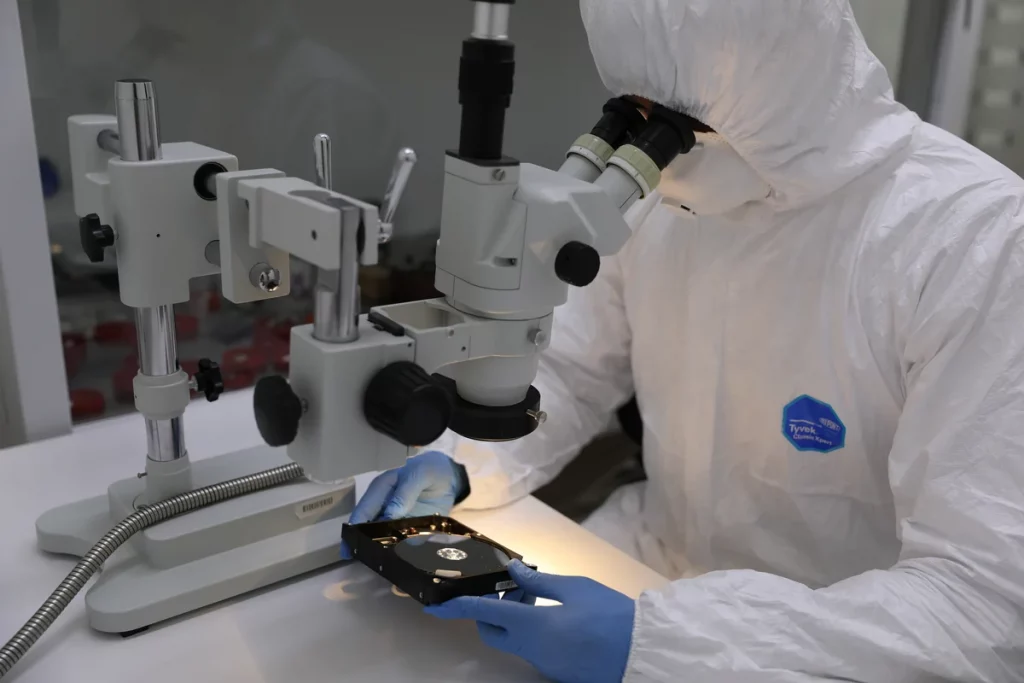Data security is of utmost importance today, and encryption has become a crucial tool to safeguard sensitive information from unauthorized access. Nevertheless, certain challenges arise when trying to recover data from encrypted devices due to the strong security measures put in place. This article will examine the complexities of recovering data from encrypted devices, including the precautions, methods, and factors to consider when unlocking encrypted data.
What is Encryption - Definition
Encryption is the act of converting text or data into a coded message, known as ciphertext, to prevent unauthorized access to the original message or data. It uses complex algorithms and mathematical functions to scramble the data so that only authorized parties can decipher it using a secret key or password.
This technique protects sensitive information, such as personal data, financial information, and intellectual property, from unauthorized access or theft. However, ransomware also uses it to restrict access to the data owner. The ransomware method encrypts the data so that only those with a decryption key can access it.
Increase Chances for Data Recovery of Encrypted Files if You Forgot Password
You have limited options if your files are encrypted, and you have forgotten the password. Unfortunately, if you do not have the password or the encryption key, it is impossible to access the encrypted files without breaking the encryption. Here are some steps you can take if you forgot the password:
- Check for any password hints. Sometimes, password hints can help you remember the password. If you have used a password hint while setting up the encryption, try to recall it.
- Contact the encryption software provider. You can contact the software provider’s customer support team if you have used third-party encryption software to encrypt your files. They can help you recover the password or provide an alternative solution.
- Try to use any possible variations of the password. If you have used a variation of the password, such as adding a number or a symbol at the end, try to use that variation.
- Restore your files from a backup. If you have a backup of your files, restore them from the backup. This will help you recover your files without breaking the encryption.
- Consult a professional. If you do not have a backup or if the backup is outdated, consult a professional data recovery service provider. They may be able to recover your files using advanced data recovery techniques.
How to Increase Chances for Encrypted Files Recovery After Ransomware
If the files on your device have become encrypted, there is a possibility that your device has been infected with ransomware. Ransomware is a kind of malicious software that encrypts data on a victim’s device and demands a ransom payment in exchange for the recovery key.
If you suspect that your storage device has been infected with ransomware, here are some steps you can take:

- Disconnect from the network. If your storage device is connected to a network, disconnect it immediately to prevent the ransomware from spreading to other devices.
- Do not pay the ransom. It is critical not to pay the ransom demanded by the ransomware attackers. Paying the ransom does not guarantee that they will decrypt the drive, and it only encourages the attackers to continue their malicious activities.
- Scan your device for malware. Use antivirus software or a malware removal tool to scan your media for malware and remove any infections.
- Restore your files from the backup. If you have a backup of your files, restore them from the backup. This will help you recover your files without paying the ransom.
- Consult a professional. If you do not have a backup or if the backup is outdated, consult a professional data recovery service provider. They may be able to recover your files using advanced data recovery techniques.
Our Process for Drive Encryption Recovery

Data recovery from encrypted storage devices can be a complex and daunting task. However, with the right methods and techniques, the PITS team safely restores data from an encrypted drive with minimal risk of data loss or corruption.
The first step in recovering encrypted data is to identify what type of encryption has been used.
This will determine the methods and techniques that can be used for successful recovery. Common types of encryption include hardware, software, key-based, and filesystem-based encryption, so it is important to recognize which has been used before starting the secure data recovery process.

The next step is to evaluate your drive to check for faults. By reviewing the drive’s physical and logical state, our engineers estimate the plan of action for recovering the maximum amount of data.
Why Choose Us
PITS Global Data Recovery Services delivers premium data recovery solutions with a focus on quality and individual care for every case. As a DUNS-verified business, we are committed to excellence, ensuring 100% customer satisfaction. Our tailored service options suit a range of recovery needs and budgets. For critical situations, we offer emergency data recovery, restoring data quickly and reliably without compromising quality.

If you’re facing a data loss situation, don’t hesitate to contact us. Our 24/7 data recovery services are available to you, 365 days a year. Let us help you recover your precious data today.

We start the recovery process with a risk-free evaluation. Our technicians estimate reasons for data loss and the level of damage. Based on it, we select the most suitable recovery strategy.

With years in the data recovery industry, our company supports the highest customer satisfaction rate. We do everything to provide a positive experience for our clients.

During our remote customer file verification session, you will thoroughly review all necessary documents and records to ensure accuracy and compliance.

We offer data recovery services from over 50 locations across the US. This means that no matter where you are located, you can access our services to recover the data.

With our certified data recovery services and 99% success rate, we are confident that we can recover your precious data and get you back up and running in no time.
Once the data recovery strategy has been identified, we extract the files using the latest decryption tools and advanced methods. Our engineers regularly attend qualification courses and maintain certificates to be able to restore files regardless of the type of storage, encryption method, brand, or storage capacity. Working with cutting-edge technologies, we safely decrypt and regain access to all the required files within a specific time frame.
When performing encrypted data recovery, our goal is to ensure that all safety measures are taken.
We support all the confidentiality standards and security requirements when recovering encrypted hard drives, SSDs, or flash drives.
Once all of the necessary steps have been taken and the encrypted files have successfully been restored, we perform a verification session. This helps verify that none of the recovered files was corrupted. In addition, a user ensures that all the high-priority data is successfully recovered.

Recovery of encrypted data from a drive is a tricky and complicated process, but with PITS Global Data Recovery Services, it is not a problem. We provide all services, including encrypted data recovery, ransomware recovery, and data destruction. Start your data recovery with us by calling our customer services or filling out the request help form below.
Frequently Asked Questions
Can encrypted data be recovered from a device?
Yes, encrypted data can be recovered from a device, but it depends on the encryption method and the complexity of the encryption key.
What is an encrypted device?
An encrypted device is a storage device that has been secured with encryption to protect the data from unauthorized access.
What are the common types of encryption?
The common types of encryption are symmetric encryption, asymmetric encryption, and hashing.
Is it possible to recover data from a device if the encryption key is lost?
If the encryption key is lost, it becomes difficult to recover the encrypted data. However, there are some techniques that can be used to recover the data.
What are the techniques used for data recovery from an encrypted device?
The techniques used for data recovery from an encrypted device include brute-force attack, dictionary attack, and forensic analysis.
Can data be recovered from a damaged encrypted device?
Yes, data can be recovered from a damaged encrypted device. However, the success rate of data recovery depends on the extent of the damage.


